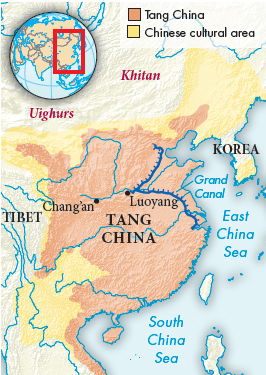The Tang Dynasty, 618–907
The dynasty founded by Li Yuan, the Tang, was one of the high points of traditional Chinese civilization. Especially during this dynasty’s first century, its capital, Chang’an, was the cultural center of East Asia. This position of strength gave the Chinese the confidence to be open to learning from the outside world, leading to a more cosmopolitan culture than in any other period before the twentieth century.

Tang China, ca. 750 C.E.
The first two Tang rulers, Gaozu (Li Yuan, r. 618–626) and Taizong (r. 626–649), were able monarchs. Adding to their armies auxiliary troops composed of Turks, Tanguts, Khitans, and other non-Chinese led by their own chieftains, they campaigned into Korea, Vietnam, and Central Asia. In 630 the Chinese turned against their former allies, the Turks, gaining territory from them and winning for Taizong the title of Great Khan.
In the civil sphere Tang emperors subdivided the administration of the empire into departments, much like the numerous agencies of modern governments. They built on the Sui precedent of using written examinations to select officials. Candidates had to master the Confucian classics and the rules of poetry, and they had to be able to analyze practical administrative and political matters. Government schools were founded to prepare the sons of officials and other young men for service as officials.
The mid-Tang Dynasty saw two women — Empress Wu and Consort Yang Guifei — rise to positions of great political power. Empress Wu was the consort of Emperor Gaozong. After Gaozong suffered a stroke in 660, she took charge. She continued to rule after Gaozong’s death, summarily deposing her own two sons and dealing harshly with all opponents. In 690 she proclaimed herself emperor, the only woman who took that title in Chinese history. Although despised by later Chinese historians as an evil usurper, Empress Wu was an effective leader. It was not until she was over eighty that members of the court were able to force her out in favor of her son.
Her grandson, the emperor Xuanzong (r. 713–756), presided over a brilliant court in his early years. In his later years, however, after he became enamored of his consort Yang Guifei, he did not want to be bothered by the details of government. The emperor allowed her to place friends and relatives in important positions in the government. One of her favorites was the general An Lushan, who rebelled in 755. Xuanzong had to flee the capital, and the troops that accompanied him forced him to have Yang Guifei executed.
The rebellion of An Lushan was devastating to the Tang Dynasty. Peace was restored only by calling on the Uighurs (WEE-gurz), a Turkish people allied with the Tang, who looted the capital after taking it from the rebels. After the rebellion was finally suppressed in 763, the central government had to keep meeting the extortionate demands of the Uighurs. Many military governors came to treat their provinces as hereditary kingdoms. In addition, eunuchs gained increasing power at court.
